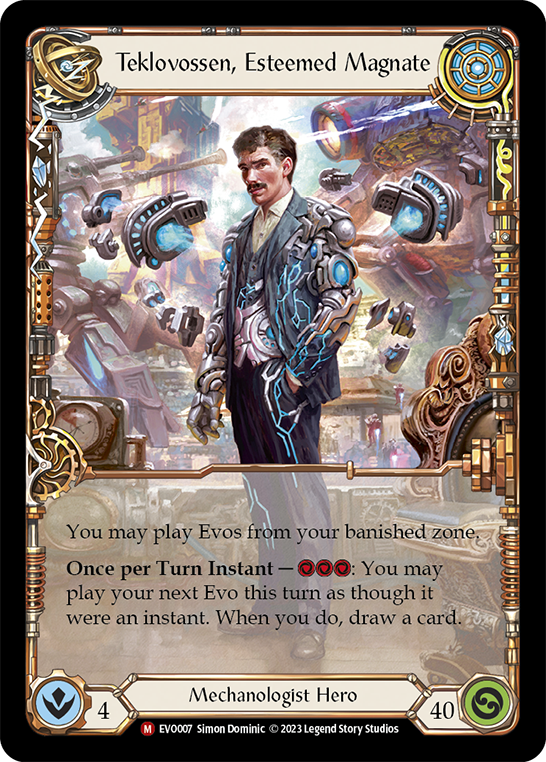
During Bright Lights spoiler season, Teklovossen, Esteemed Magnate stood out to me as a hero that really highlighted what I find fun as a player. A deck with a build-your-own fridge that would embarrass a Guardian, combined with Wizard-like instant speed shenanigans? I was hooked, and started brewing lists immediately.
My initial drafts included lots of boost cards. I was fixated on that first line of text on his hero power: “You may play Evos from your banished zone.” If you banish an Evo during a boost, that’s essentially drawing a card!
But then Prerelease weekend happened; and as I played more and more EVO sealed and draft, it became very clear that blocking with Evos from hand and then scrapping them into your banished zone was a very strong play pattern, essentially letting you double-dip on the value of your Evos. I immediately started trying to fit red and blue scrap cards into my constructed Teklovossen deck lists.
Space in this deck is extremely tight, and trying to cram full packages of both boost and scrap into 80 cards felt nearly impossible. I had to make hard cuts.
This left me wondering: what was better, boosting or scrapping? And I wasn’t just interested in the heuristic “I’ve played 10 games with each strategy and this feels better” answer you might get from preliminary testing. I wanted a crunchy, break-down-the-numbers math perspective, which I didn’t really see anyone else doing with the hero when I checked in on public discussion spaces.
So, I did what any logical person would do. I did the math on every red and blue boost and scrap card.
That’s right. Not the best ones. Not “most” boost and scrap cards.
Every. Single. One.
(Except blue Combustible Courier, that card is laughably bad and I don’t need to do the math to be able to tell that at a glance.)

Let’s check the results and interpret them together!
Establishing Assumptions
(If you aren’t interested in the nitty-gritty stuff and just want the answers, jump ahead to The Math.)
First, we need to lay the groundwork for what exactly we want to know. We’re interested in the “value” of boost cards vs scrap cards. Value here is defined as the sum total of offensive damage presented plus defensive damage blocked.
Value = Offensive Damage Presented + Defensive Damage Prevented
Maximizing value is a great goal. But you can look at a deck of sixty 3-power attack action cards and say “wow, this deck has 180 value! That’s four times any hero’s life total! It must be a great list!”
So to be more specific, we’re interested in maximizing the value achieved relative to the cards we invest. The equation here is simple: Value Per Card (VPC) is the ratio of the total value generated by a play line to the cards spent to carry out that play line (a higher number is better). This should intuitively make sense; a hand of four cards that generates 16 value is better than a hand of four cards that generates 12 value.
Value Per Card (VPC) = Value / Cards Spent
The only units this equation considers are value and cards. To use it, we need to be able to consider all costs of playing a card in terms of cards and fractions of cards (there’s no separate term for resources). So, we’re going to make an assumption: you can always spend your resources perfectly without wasting any on a given turn – and as a result, one resource is worth exactly one-third of a card. So, playing red Zipper Hit costs 1.33 (repeating, of course) cards and generates 5 value.
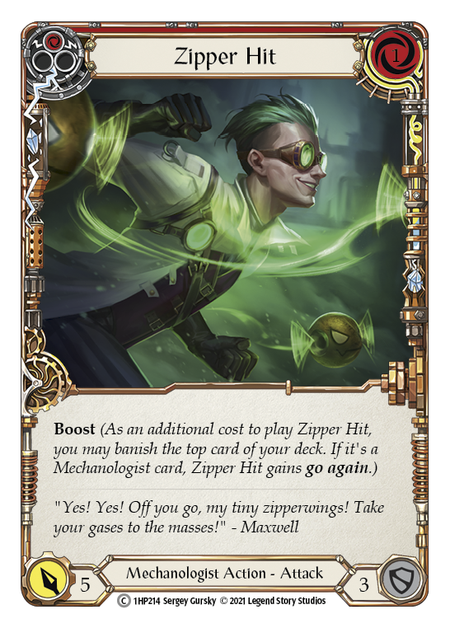
There’s one other game currency that’s missing here: action points. For simplicity’s sake, I will not be assigning action points value during my math calculations here. I’ll discuss the implications of this simplification later in the Discussion section.
Now we could jump straight in right now, but for reasons that will become apparent later, there’s one more measure I’d like to include: Card-Normalized Value (CNV). While VPC looks at how much value each card is getting you on average, CNV instead looks at how “above rate” an entire play line is compared to a baseline heuristic of “every card is worth roughly 3 value.” Intuitively, CNV asks the question “is it more value to play this card, or block 3 with it?” The exact calculation for CNV is as follows (higher is better):
Card-Normalized Value (CNV) = Value – ( 3 * Cards Spent)
Those are our major assumptions and equations, but there are a handful of small housekeeping things left:
We assume we are playing a 60-card deck with 20 Evos (12 Steel Souls, 8 Sentry Bases). This means boosting a card will banish an Evo one third of the time. This is a ratio I have empirically found to be acceptable; optimizing this ratio is an entirely different article and probably above my pay grade.
We only consider cards and card fractions spent from hand when we define Cards Spent for evaluating VPC and CNV, as your four intellect is generally the limiting factor when it comes to generating resources in Flesh and Blood. (EG, playing a Sentry Base from banished costs 0.67 cards, not 1.67 cards)
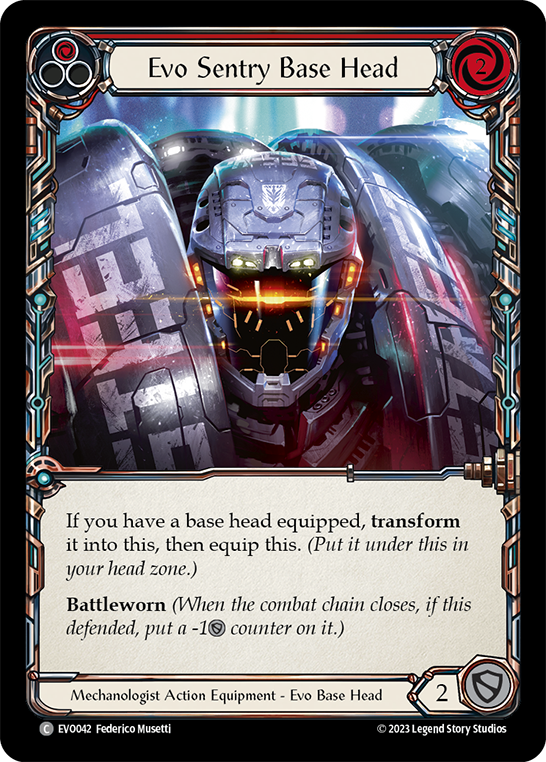
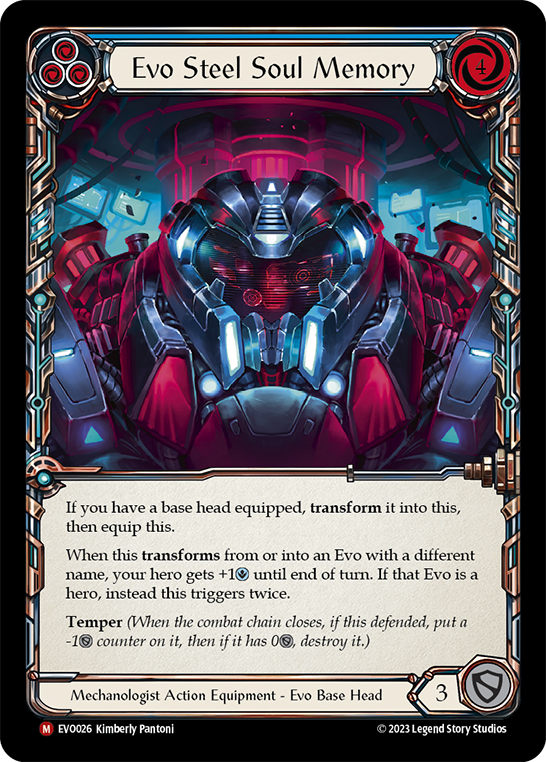
The value of Steel Soul triggers are ignored here; you will get them whether you boost or scrap, so it should all even out anyways.
The value of an Evo is defined as the amount of block value it can generate without being destroyed: 3 for Sentry Bases with Battleworn: 2 and 5 for Steel Souls with Temper: 3. (Technically, you can utilize the 6th point of value on a Steel Soul by playing a new Evo during a chain link resolution step without the Evo breaking, but in my experience this happens rarely enough to ignore it for value calculations.)
Any value generated by rules text on cards that isn’t “scrap” or “boost” and doesn’t explicitly generate value (looking at you, Junkyard Dogg) is generally ignored, except for Scrap Trader. As an example, the resource generated by Scrap Prospector isn’t considered as -0.33 cards spent.
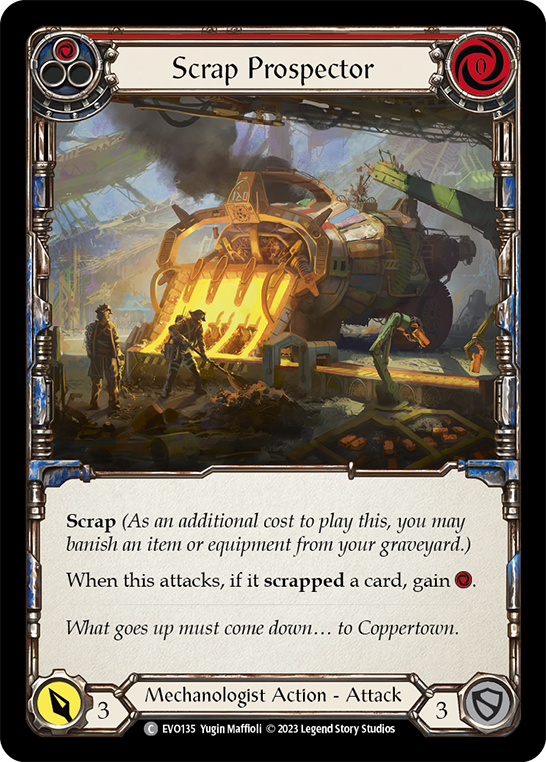
Scrap cards are assumed to scrap an Evo every time they’re played. Boost cards are assumed to banish an Evo 33% of the time.
The Math
…is something I won’t bore you with here, as it would be a wall of bullet points and numbers. If you’re interested in the calculations for any specific card, I have prepared a Google Document that shows my work, which can be found here.
The document is set to comment mode. If you find any errors or have any questions, please feel free to either comment below or on the document itself.
If you aren’t interested in scrolling through 10 pages of play lines, worry not! I have also created a TL;DR spreadsheet, which sorts the red and blue cards investigated here in descending order of Mean Card-Normalized Value (MCNV) and Mean Value Per Card (MVPC).
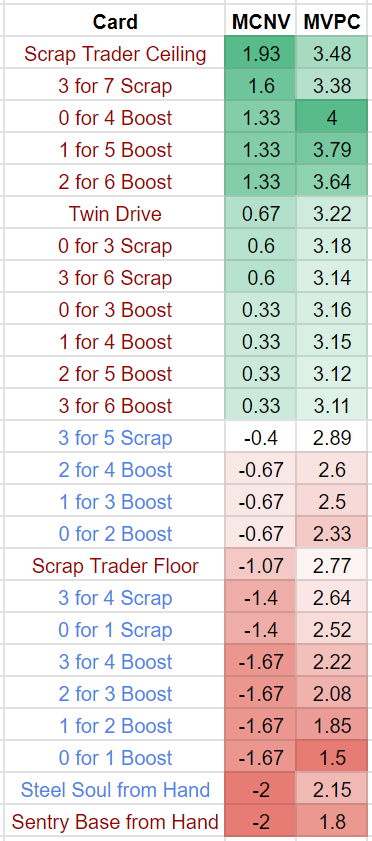
This table summarizes the main findings of my little experiment, and warrants a thorough discussion.
Discussion
There are some fascinating trends going on here. What I find mildly interesting (though in retrospect should probably be unsurprising) is that cost cycles tend to get clumped together in terms of CNV. In general, red Junkyard Dogg stands out as the best (or at least most consistent) card for generating value as you equip Evos.
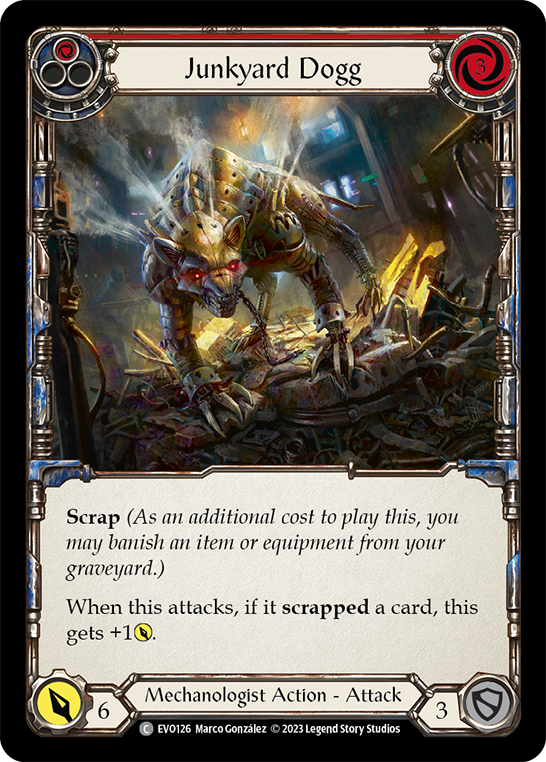
That being said, nipping at its heels are the vanilla Arcane Rising boost cards: Zero to Sixty, Zipper Hit, and Throttle. This trio holds the first-place prize with respect to Value Per Card among boosters, and the drop from them to the next best card, Twin Drive, sees the Mean Card-Normalized Value slashed in half. If I were to draw an arbitrary line in the sand on where red cards go from appealing to questionable, it would be somewhere between Throttle and Twin Drive.
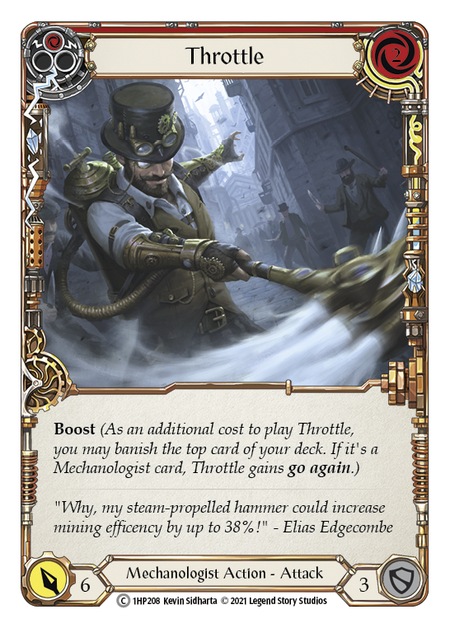
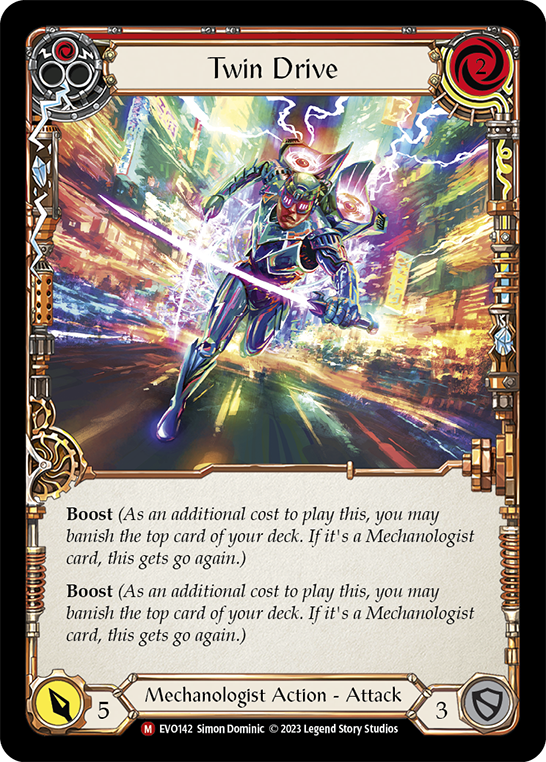
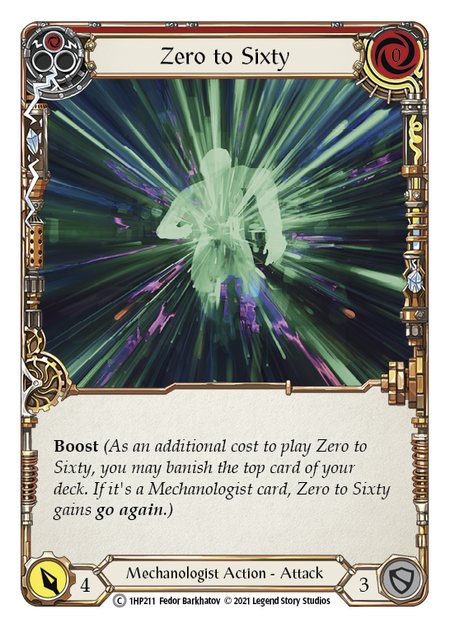
Notably, I did skip a card – the very best MCNV performing card, Scrap Trader. Except… Scrap Trader is also the worst MCNV performing card, aside from playing Evos from hand!
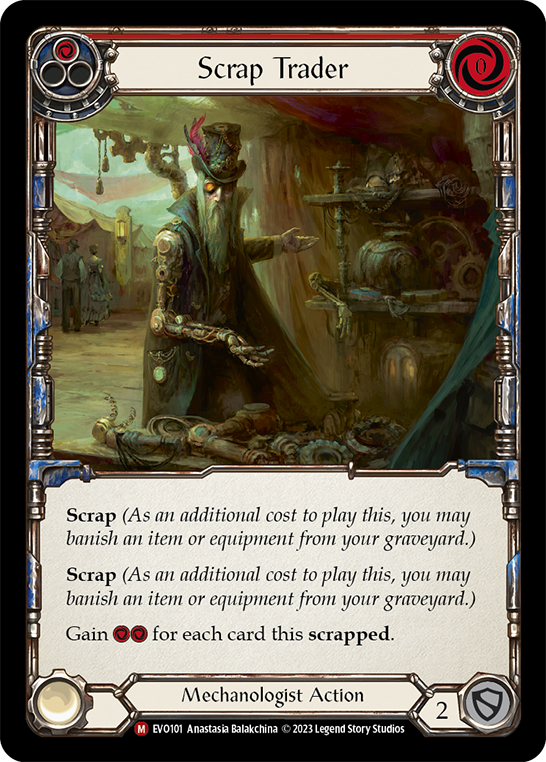
By the numbers, Scrap Trader is a complicated card, and I only begin to scratch the surface of it in the play lines I consider when calculating these numbers. To fully utilize the four resources that Scrap Trader generates, I assume you are pairing it with Teklovossen’s instant ability. The variation between Scrap Trader’s ceiling and floor all comes solely from how much the card that you redraw from Teklovossen’s ability is worth. If it’s worthless and you can’t arsenal it? Scrap Trader is the worst red in the deck in those moments, and it isn’t particularly close. But if you can comfortably arsenal the random draw and get a full card’s worth of value out of it? Scrap Trader is the best red in the deck in those moments.
Side note: If you can, avoid playing Evos from hand – the value is impressively atrocious.
We see the same trends replicated in the blues – Junkyard Dogg is the best, then the trio of vanilla boost cards, and then a sharp drop down to the 3 for 4 scrap cards… but, strangely, only in Mean Card-Normalized Value? In fact, the Mean Value Per Card for blue Hydraulic Press and Scrap Harvester is the second highest among all blues, which is surprising!
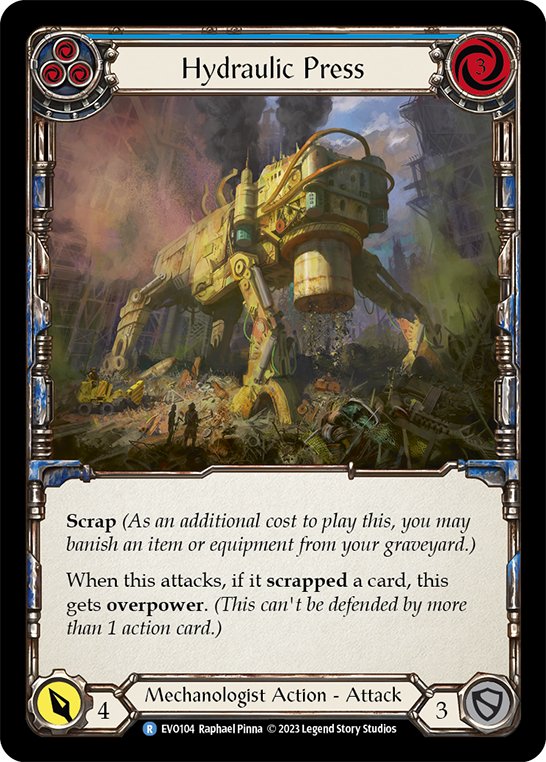
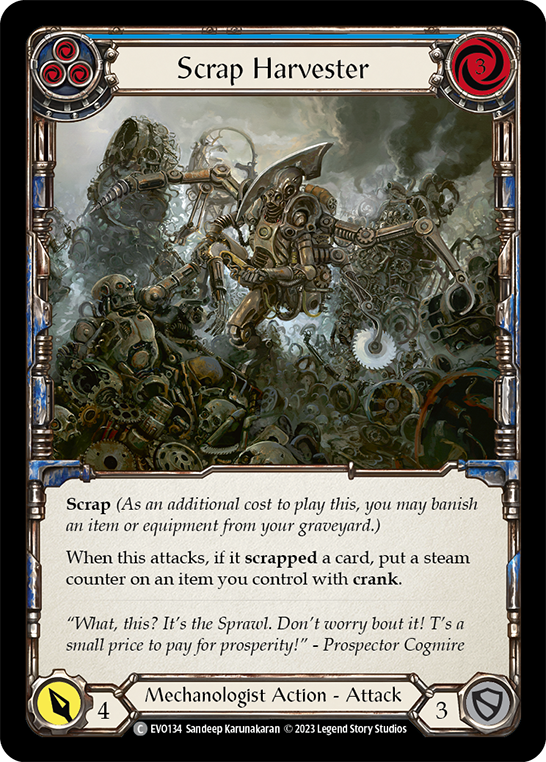
But, before you scramble to start sleeving up these cards, let me let you in on a little secret. When I originally did these calculations, I was only looking at MVPC. I was shocked to see Hydraulic Press worth so much at first blush (let’s be real, there are no crank items in most Teklovossen lists, so I’m gonna drop the pretense that you might play Scrap Harvester).
I immediately jammed it into my 80… and was immediately underwhelmed. So I started digging into why its number was so high, and I shortly had a realization that VPC was an incomplete picture of the value of a play, and there’s a simple comparison to highlight this:
Play blue Scrap Compactor (1 card, 1 value, 1 VPC)
Block with Titanium Bauble. Play blue Scrap Compactor (2 cards, 4 value, 2 VPC).
Block with three Titanium Baubles. Play blue Scrap Compactor (4 cards, 10 value, 2.5 VPC)
If we’re valuing offense and defense equally, from a value perspective there’s no difference between blocking with a Titanium Bauble and playing Scrap Compactor versus playing Hydraulic Press. But because we’re adding an extra card and on-rate value to Hydraulic Press’ play line via its resource cost, at a glance it looks better than Compactor. This unfair comparison is what motivated me to include Card-Normalized Value as the primary evaluation metric - and sure enough, we see 3 for 4 scraps and 0 for 1 scraps having the same CNV. Let this be a lesson: always be ready to critically think about your results, and don’t blindly trust patterns or outliers.
Importantly, unless things are going really poorly with your Scrap Trader, any red is better than any blue, and they are all above rate, though some just barely. While I can’t in good conscience recommend you put Zero to Fifty in your deck, this does mean that it’s not explicitly wrong to play either boost or scrap exclusively, or a mix of the two – both of them end up holding their own weight versus a benchmark “minimum 12 value per hand” check.
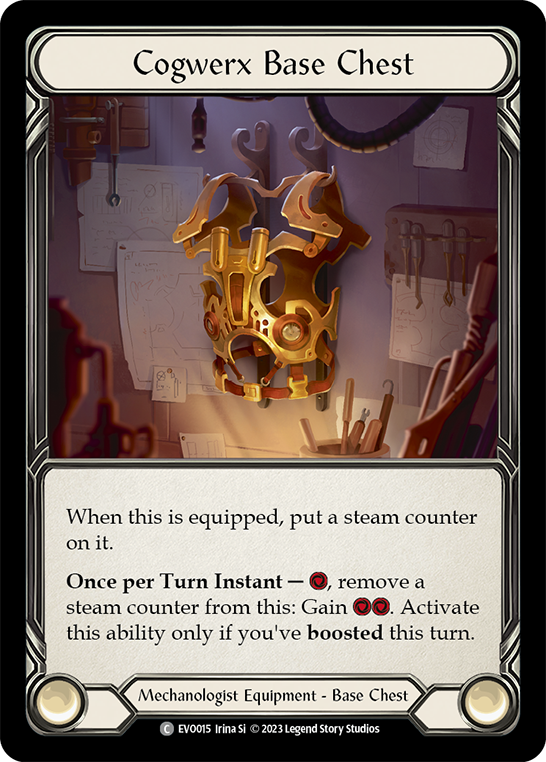
That said, I personally can see pros and cons to either method outside the raw numbers. Perhaps the biggest is that consistently boosting unlocks the steam counter text on the Cogwerx Base set of equipment. These possess strong, relevant effects; the chest lets you play a Steel Soul with just a blue, the legs do a decent Snapdragon Scalers impersonation, and the head can re-buy a Terminator Tank that you accidentally boost away.
However, boosting is an inherently high-variance strategy. The numbers I present here consider what your value should look like on average over dozens and dozens of games. With boosting, sometimes you’ll have four Evos in your banished zone by turn two… and sometimes you simply won’t banish any all game.
Conversely, you will draw Evos at some point or another, it is simply unavoidable. We’ve already seen that playing them from hand isn’t really an acceptable answer, which means your best bet is to pitch them… or block with them, which of course is where scrap shines. Considering that drawing Evos is an inevitability compared to boost’s variance, I personally find it nearly impossible to build a Teklovossen list that’s trying to take itself seriously without including some amount of red scrap cards. Luckily, the numbers are pretty clear on which ones we should be playing: Junkyard Dogg, and maybe Scrap Trader.
And lastly, the elephant in the room: simplifying action points to be valueless is a gross oversimplification on my part, largely because I don’t want to deal with the headache-inducing question of “how much value is an action point worth?” It starts with saying “Oh, well boost cards always refund an action point,” and leads to “Is the instant Evo ability of Scrap Compactor worth an action point?” which devolves to “What are the odds you can actually utilize the Quicken token created by Scrap Hopper?” and each question only gets harder to answer.
Action points are inarguably worth something. The true numbers on the boost cards are probably slightly better than the math here suggests. How much better? I’m not sure, but considering they already have some of the highest CNVs of all reds, it creates a very strong argument for playing them over most - if not all - red scrap cards.
Sample List and Conclusion
So, where does all this leave us? My personal takeaways are that it feels wrong to make a Teklovossen deck that doesn’t play Junkyard Dogg and the trio of Arcane Rising boost cards in the mainboard. They all simply offer an incredible amount of bang for their buck. And while that probably isn’t a ground-shaking revelation to anyone that’s spent a reasonable amount of time playing Teklovossen, I think it’s comforting to see the data back up your intuition as a player. If I were to draft a Teklovossen deck strictly based on the results seen here, it would probably look something like this.
While I don’t expect real, tournament-winning Teklovossen lists to look as cookie-cutter clean as this 60, I think it’s a very reasonable, data-driven starting point for readers to playtest and tweak to their liking – at least, that’s exactly what I’m doing. There’s a million ways to build successful decks in FaB, and brewing is often more of an art than an exact science; I didn’t even touch on implied value of any cards in this article. It may be that, after some time, it’s agreed on that the most successful lists still end up leaning hard into only boost or only scrap. But me? I’m a dreamer, and I’m a sucker for a good hybrid deck.
The inclusion of action points in value evaluation is left as an exercise for the reader.




